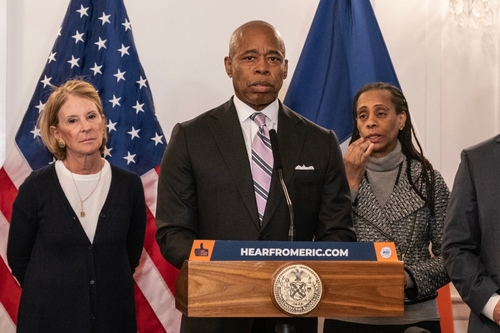
New York City’s migrant crisis spirals as hotel room costs soar to $2.3 billion, straining city resources and tourism. With over 200,00 migrants arriving in NYC since 2022 and thousands expected each week, the Department of Homeless Services now seeks more hotel rooms. Mayor Eric Adams has been scrutinized for his housing cost approach. He recently spoke out about how unsustainable financially this has become resulting in the eviction of migrants.
NYC’s Migrant Crisis Strains City Resources
New York City is grappling with an unprecedented migrant crisis that has pushed its housing resources to the brink. Since 2022, over 200,000 migrants have arrived in the city, many transported by GOP governors from the southern border. The influx has forced city officials to seek emergency solutions, including the controversial use of hotel rooms as temporary shelters.
The Department of Homeless Services is now seeking a contractor to manage the acquisition of 14,000 hotel rooms for migrants, with more than 150 hotels currently in use. The average cost per room per night stands at a staggering $352, contributing to a potential total expenditure exceeding $2.3 billion. This financial burden has sparked intense debate about the sustainability of such measures and their impact on the city’s economy and tourism industry.
The Roosevelt Hotel NYC.
City officials are reporting that over 700 migrants are still arriving in NYC per week .
Over 300k migrants have been through NYC funded shelters and hotels .
The cost of the migrant crisis is over 5.6 billion dollars per year .
NYC has not received… pic.twitter.com/rIMhSEyNJr
— Viral News NYC (@ViralNewsNYC) September 20, 2024
Impact on Tourism and City Economy
The use of hotels as migrant shelters has raised concerns about New York City’s vital tourism sector. Iconic establishments like the Row NYC Hotel in Times Square and the Roosevelt near Grand Central have been repurposed to house migrants, potentially affecting the city’s appeal to visitors. Nicole Gelinas of the Manhattan Institute, a conservative think tank, has voiced strong criticism of this approach.
“The taxpayers can’t pay for this indefinitely,” Nicole Gelinas of the Manhattan Institute think tank told the NY Post. “We should stop using hotels as shelters by the end of the year.”
Gelinas suggests that the practice of converting hotels in Manhattan’s tourist districts into migrant shelters should cease by year’s end. However, hotels in outer boroughs are benefiting financially from the arrangement due to lower occupancy rates and a reliable revenue stream from the city.
City’s Response and Challenges
Mayor Eric Adams faces mounting criticism as the cost of housing migrants approaches $2.3 billion, with projections reaching $5.76 billion by the end of next year. In response to the crisis, the city has implemented several measures, including the establishment of tent cities and emergency shelter sites at various locations such as Floyd Bennett Field and Kennedy Airport.
“The ability to close the Randall’s Island humanitarian relief center marks the latest milestone we have reached as an administration addressing this humanitarian crisis,” said the Mayor’s asylum seeker chief Molly Schaeffer.
The city is now dismantling its largest shelter on Randall’s Island, notorious for violence, with plans to close it by March. This move is seen as a significant step in addressing the migrant crisis, with intentions to restore the site to a public park. Additionally, Mayor Adams has taken controversial steps such as abandoning the Right to Shelter law and reducing shelter stay limits to alleviate financial strain.
Financial Implications and Future Outlook
The New York City Hotel Association, led by CEO Vijay Dandapani, is playing a crucial role in managing migrant housing contracts. The association’s foundation receives about $100,000 monthly to oversee existing agreements with the city and is applying for a new contract to manage large-scale hotel shelters as part of the City Sanctuary Facility program.
“We have five full-time employees specifically for fulfilling the contractual obligations, besides work done by regular HANYC staff for the contract, in addition to their normal duties,” said CEO, Vijay Dandapani.
While the city’s Asylum Funding Tracker indicates a projected decrease in migrant shelter costs from $1.51 billion last year to $233 million by the fiscal year ending June 30, 2025, the situation remains precarious. The implementation of 30-day shelter limits for individuals and 60 days for families has helped reduce the migrant population in shelters, but long-term solutions are still needed to address this complex humanitarian and economic challenge facing New York City.












